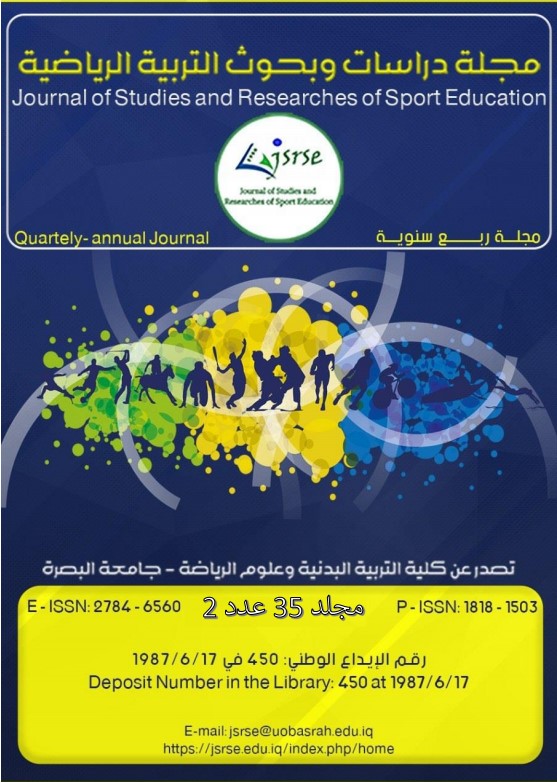Studying the reality of bullying levels in the sports field for players of some individual and team games (Analytical study)
Main Article Content
Abstract
The aim of the research was to build and standardize a bullying scale in the sports environment for players of some team and individual games. The researchers used the descriptive approach with the survey method to suit the nature of the problem. The research sample consisted of 185 athletes in a random manner. The participatory observation tool and the questionnaire tool were adopted. After collecting information, analyzing the questionnaire data, and using statistical methods and repetitions, we reached the most important results: Building and standardizing a tool to measure bullying in the sports environment in some team and individual games. One of the most important recommendations presented in this research is the necessity of conducting educational and psychological workshops and seminars to demonstrate the danger of bullying on the psychological and behavioral aspects of athletes.
Article Details

This work is licensed under a Creative Commons Attribution-NonCommercial 4.0 International License.
References
Abdullah, A.-S., & Maher, A.-D. (2003). Psychological and Educational Measurement and Evaluation between Theory and Application (1st ed). Wael House.
Adler, A. L. (2014). An examination into bullying in the adolescent sport context. Unpublished Master’s Thesis, Queen’s University.
Ahmed, M. S., Fathi, A. M., & Ajami, M. I. (2023). Comparative study in the level of depression according to the sex variable of practitioners and non-practitioners of sports activities. Anbar University Journal of Physical Sciences and Sports, 6(26), 417–432. https://doi.org/10.37655/uaspesj.2023.140841.1054
Awiria, O. (1994). Bullying at school-what we know and what we can do. JSTOR.
Bredemeier, B. J. (1983). Athletic aggression: A moral concern. In Sports violence (pp. 47–81). Springer.
Cleary, S. D. (2000). Adolescent victimization and associated suicidal and violent behaviors. Adolescence, 35(140).
Cummings, J. G., Pepler, D. J., Mishna, F., & Craig, W. M. (2006). Bullying and victimization among students with exceptionalities.
Delfabbro, P., Winefield, T., Trainor, S., Dollard, M., Anderson, S., Metzer, J., & Hammarstrom, A. (2006). Peer and teacher bullying/victimization of South Australian secondary school students: Prevalence and psychosocial profiles. British Journal of Educational Psychology, 76(1), 71–90.
Farhat, L. E.-S. (2001). Measurement and testing in physical education. Cairo: Book Center for Publishing.
Farrington, D. P., Loeber, R., Stallings, R., & Ttofi, M. M. (2011). Bullying perpetration and victimization as predictors of delinquency and depression in the Pittsburgh Youth Study. Journal of Aggression, Conflict and Peace Research, 3(2), 74–81.
Fekkes, M., Pijpers, F. I. M., & Verloove-Vanhorick, S. P. (2004). Bullying behavior and associations with psychosomatic complaints and depression in victims. The Journal of Pediatrics, 144(1), 17–22.
Gruber, J. E., & Fineran, S. (2007). The impact of bullying and sexual harassment on middle and high school girls. Violence against Women, 13(6), 627–643.
Hamburger, M. E., Basile, K. C., & Vivolo, A. M. (2011). Measuring bullying victimization, perpetration, and bystander experiences; a compendium of assessment tools.
Hugh‐Jones, S., & Smith, P. K. (1999). Self‐reports of short‐and long‐term effects of bullying on children who stammer. British Journal of Educational Psychology, 69(2), 141–158.
Marques، M. (2005). Play Fighting and bullying in Playground. Doctoral Thesis presented to Faculty of Human Kinetics. Technical University of Lisbon.
Marsh, H. W., Nagengast, B., Morin, A. J. S., Parada, R. H., Craven, R. G., & Hamilton, L. R. (2011). Construct validity of the multidimensional structure of bullying and victimization: An application of exploratory structural equation modeling. Journal of Educational Psychology, 103(3), 701.
Nery, M., Neto, C., Rosado, A., & Smith, P. K. (2019). Bullying in youth sport training: A nationwide exploratory and descriptive research in Portugal. European Journal of Developmental Psychology, 16(4), 447–463.
Pepler, D. J., Craig, W. M., Connolly, J. A., Yuile, A., McMaster, L., & Jiang, D. (2006). A developmental perspective on bullying. Aggressive Behavior: Official Journal of the International Society for Research on Aggression, 32(4), 376–384.
Van Raalte, J. L., Cornelius, A. E., Linder, D. E., & Brewer, B. W. (2007). The relationship between hazing and team cohesion. Journal of Sport Behavior, 30(4), 491.
Weiss, M. R., Smith, A. L., & Theeboom, M. (1996). “That’s what friends are for”: Children’s and teenagers’ perceptions of peer relationships in the sport domain. Journal of Sport and Exercise Psychology, 18(4), 347–379.
Ybarra, M. L., & Mitchell, K. J. (2004). Youth engaging in online harassment: Associations with caregiver–child relationships, Internet use, and personal characteristics. Journal of Adolescence, 27(3), 319–336.





 IASJ
IASJ CC-BY-4.0
CC-BY-4.0 turnitin
turnitin ISSN
ISSN DOAJ
DOAJ Crossref
Crossref GoogleScholar
GoogleScholar Orcid
Orcid